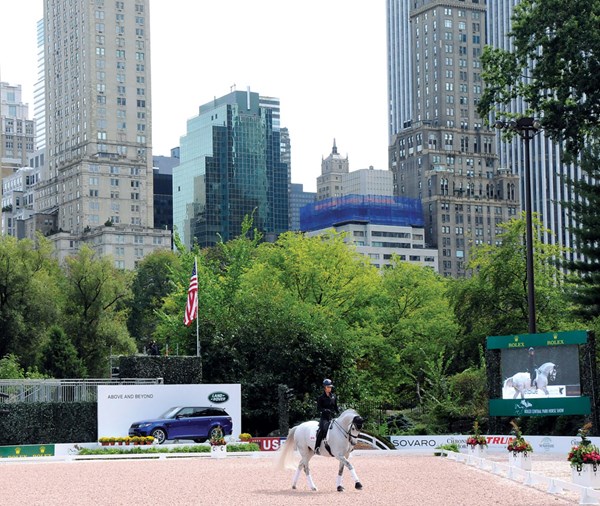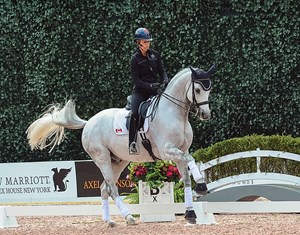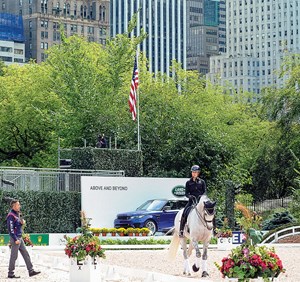It was one of those “make lemonade out of lemons” situations: The Rolex Central Park Horse Show had proudly announced that Charlotte Dujardin, the world’s No. 1-ranked dressage rider, would be appearing in the Wollman Rink with Valegro, the world’s No. 1-ranked dressage horse. Then Valegro’s connections decided it would be too much for him to make an overseas trip in September after his multi-medal European Championships outing in August.

So Charlotte honored the contract on her own, and U.S. Dressage Coach Robert Dover fixed her up with a catch ride, Evi Strasser’s beautiful but challenging Renaissance Tyme. Charlotte, unconcerned about what could happen to her image by putting on a less-than-perfect performance with a horse she didn’t know, gave an exhibition during the freestyle competition. She also agreed to present a master class that closed the show on Sunday, where she offered tips and thoughts that were useful for rapt spectators, whether their experience was at Training Level or Grand Prix. Robert commentated, adding his views to a valuable package that offered insight into the way she works her magic. And the fact that Charlotte had moments where all did not go smoothly with her new mount gave the superstar some common ground with her audience. The following is advice Charlotte shared during her ride in Manhattan:
Despite a late announcement that the presentation was being offered, the stands were about two-thirds full of fans, eager to hear what Charlotte could tell them about how to develop a horse. The master class was the day after Charlotte rode a freestyle exhibition to the same “How to Train Your Dragon” music she uses with Valegro. Wisely, she made the choreography easier since she was unfamiliar with the 12-year-old Renaissance Tyme (Royal Diamond x Dream of Heidelberg).
Dressed in black, a nice contrast to her mount’s gray coat, Charlotte went through the building blocks of her training routine aboard Evi’s high-energy Oldenburg. She started by explaining the importance of a proper warm-up, beginning by stretching the horse, making him relaxed, supple and as loose as possible before getting into serious work. “What I’m trying to do is get the base to be as long and low and stretched as possible, so that behind the saddle, he raises his back and these muscles here start to move and he uses himself in the right way,” she said as she placed her hand on the area behind the saddle.
While warming up, Charlotte kept her hands low, trying to get the horse as even in the contact as possible. She compared a horse to a gymnast, noting that you wouldn’t expect gymnasts to go through their routine without the proper warm-up, adding that the same principle applies to any athlete.
At home in England, even before Charlotte mounts up, the routine for the horses begins with riders from her barn taking them for a 15-minute hack. The proper warm-up sets the tone for the work. “This is the foundation. It’s like building a house. If you have a bad foundation, you’re going to have a bad house. If you have bad basics on a horse, you’re going to run into problems,” she pointed out.
How many dressage horses never leave the ring except for a little hand-grazing? Charlotte’s horses are on a completely different program. They go for trail rides on the roads and fields twice a week and have the day off on Sunday, when they are turned out to relax—even Valegro. This is all part of a schedule that keeps them fresh. The fact that they’ve seen things other than the arena makes it easier for them when they go to shows.
Charlotte emphasized that everything must be done correctly from the first step and mistakes should be corrected properly and promptly. She believes that bad habits start when a horse makes a mistake and is allowed to stop. Robert agreed, noting how the spectators were fortunate to witness challenges in Charlotte’s ride and how she reacted to them.

“It’s all about repetition, correction and being strong with yourself,” Charlotte said. “A rider needs discipline and cannot let bad habits happen. If you make bad transitions at home just because you’re lazy or not really thinking about it, you’re going to make bad transitions in the arena. When someone says about their horse’s performance, ‘Oh well, he did this or he did that,’ that’s because you allowed him in the first place to make all those mistakes.”
After Renaissance Tyme made an error in a flying change, Charlotte corrected him immediately, then moved on, illustrating what she was saying. She noted, “It’s important you work with the horse, not against him,” and a case in point was the harmony she had achieved in a short time with an animal who obviously was not an easy ride. “If he’s afraid of something, I can reassure him and be positive and say ‘it’s OK’ and then he trusts me and carries on, rather than being afraid,” she commented.
To ease the tension in the horse, she rode every moment of the walk, guiding him in slow, deliberate steps until she had him where she wanted him, then let him stride out. “When he starts to take over, I literally ride the walk until I feel I’m in control,” she said. “Then I can give the rein a bit.”
She noted that some horses find it easier to start their work with the canter rather than the trot. Whichever gait is being pursued, however, she said, “When I touch him with my reins, he should stop. If I touch him with my leg, he should go. So he always learns to wait for me and not ever take over.”
Charlotte noted that the extended and collected walk movements have double co-efficients in a test and that those are big marks to lose because of tension. Robert observed how she is keyed into the basic gaits. “It’s in her nature to only ride a correct walk, a correct trot and a correct canter,” he said. “There are balance issues and rhythm issues she is dealing with without realizing she’s actually doing it. It just shows the quality of this rider.”
When it comes to a horse’s gaits, Charlotte says she looks for quality in the walk and the canter when horse shopping. While she believes you can make a horse better, she doesn’t believe the walk and canter can be changed the way the trot can—by teaching suspension, which allows the horse to lengthen and float. “Even an ugly horse you can make look pretty special,” she contended.
To bring the horse’s back up in self-carriage and create this suspension, she touches him with her legs and rides a half halt. Then she rides forward and tries to keep the suspension in the trot.
Charlotte emphasized the horse’s straightness when riding down the long side of the ring. She asked the crowd, “What is straightness?” She then explained that for a horse to be straight, he has to have his head and neck in front of his chest. Then she demonstrated how to use the corners and the short side of the ring to get the horse back and prepare for the next long side. The horse was wrapped around her inside leg in the corners, and as Robert noted, the short side is where the rider practices half halts and riding from half halt to half halt, which is “calling the horse to a perfect state of balance so he’s prepared to go through that doorway into the next movement or gait or pace as you choose.”
“If I ride a bad corner, I’m going to ride a bad movement,” Charlotte pointed out. She noted the horse has to find his own self-carriage and his own balance. She insists the horse carry his own head and neck. “It’s not my job. He has to canter for himself. I just sit there,” she said.
Leg yield in canter isn’t a movement in the test, but it’s a way to keep the horse supple and sideways off the leg, Charlotte advised. As she canters, she asks herself, Is he using his own self-carriage? Is he in good balance? Is the canter in good rhythm?
The rubber-band exercise, which she demonstrated, involved bringing the horse forward and back, rather than remaining in one steady gait. “If I touch him with my legs, it means ‘Go,’” Charlotte said. “And if I touch him with my reins, it means ‘Whoa.’ So he slows down and understands that right from the beginning, right from a young horse, he has to learn these aids.”

She noted that every horse has a good side and a bad side, where it’s harder for him to accomplish his work. “As a rider, it’s always easy to not do the hard side. You always want to ride in the good direction, the easy side,” she conceded. “You have to do a bit more with the bad side to make it as good as the good side.” Only focusing on the easy side, she said, is cheating.
Renaissance Tyme, for instance, found it easier to proceed on the left side, while depending more on his rider on the right side. But by the time Charlotte finished with training a working pirouette, his right side had improved. At the same time, she said, “You don’t want to do too much on the bad side [so] that you upset your horse.”
Charlotte cautioned against going on and on with the working part of a ride, stating that if the horse is really tired, he can wind up using his muscles in the wrong way. “When he does something good, give him a walk and a breather,” she advised. “As a rider, you’ve got to be able to feel how much work the horse can take. Don’t go until he gets tired and isn’t working with you. It’s so important you keep your horse happy so he enjoys every day of his work.”
Focusing on flying changes, Charlotte emphasized that each rider has a different method of signaling his or her horse to do the movement. During her freestyle, she made mistakes in the one-tempi changes, not knowing exactly which buttons to push on Renaissance Tyme. He also has changes that swing from side to side—rather than pushing forward, he pushes to the side when he changes. As a result, Charlotte trained him on the long side of the arena, using the wall to keep him straight, and never changed leads along the diagonal, where there was nothing to guide him. She also half halted after every change, which kept him on target.
Ideally, she pointed out, the change should be bigger than the canter stride. “Everybody can do a flying change, but what makes you get a 10 for your flying changes is the height and the quality of the canter in between and the rhythm of the change,” Charlotte commented.
When Renaissance Tyme struggled with his changes, she didn’t make an issue of it, she just kept going, pointing out that the more you make an issue of it, the tenser the horse becomes, and then the changes never come. She pointed out that to do changes well, you have to be very quick with your legs, rather than wait for the horse to do it himself. “The rider has to stay in control of the changes, and should not let the horse speed up,” she said.
Robert pointed out that if the rein contact suddenly gets weak while the rider is attempting the changes, then it’s hard because there’s nothing with which to make a half halt between changes. The connection between seat, leg and reins has to be effective in order to achieve the changes.
Moving on to piaffe and passage, Charlotte created lift and suspension by shortening her reins and touching the horse with her leg as he went into passage. Then she practiced the piaffe going forward rather than keeping him on the spot. She warned that practicing piaffe on the spot causes a tremendous amount of strain. A horse trained that way won’t last, she said, and also will get behind the leg. By allowing the horse to train piaffe forward he can see a way out, and it’s a method for obtaining a good transition into passage because he has to stay thinking forward.
She noted, “The sitting motions are the piaffe and the pirouettes, and the pushing are the extensions and the passage. To have a horse who is talented to do both of those is very hard. It’s the horses who can do both of those things that make very talented horses.”
As Charlotte continued through the session, she went through a mental checklist: Can I bend him? Can I straighten him? Can I stretch him? Can I collect him? “If I can do all those things, I know I have a good horse.”
Riding in The Big Apple
Charlotte had an eventful weekend, marked by the visit of Pope Francis to New York City and a Beyoncé concert in the park on the night of the freestyle. “I had a fantastic time,” she said. “Who gets to ride in Central Park and gets to see the Pope and [have] Beyoncé in the background? It’s been a great privilege to be here and it’s been amazing to ride here. The backdrop is incredible and the arena is incredible.”
Evi was impressed by her horse’s progress under Charlotte’s direction. She plans to work with her again and it looks as if the horse will be spending some time in England. Of the difference Charlotte made, Evi said with a grin, “He’s a Ferrari now. She tuned him up. She got him even more connected. He’s a totally different horse.”











